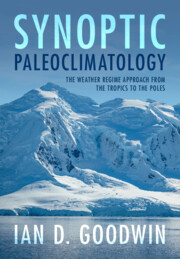Book contents
- Synoptic Paleoclimatology
- Synoptic Paleoclimatology
- Copyright page
- Contents
- Preface
- Acknowledgements
- Part I Atmosphere–Ocean Circulation and Synoptic Paleoclimatology
- Part II Synoptic Circulation and Weather Regimes
- Part III Synoptic Paleoclimate from the Natural Archive – Environmental Impact to PaleoWeather Regimes
- Part IV Synoptic Paleoclimate Reconstruction, Data–Model Assimilation, and Causal Networks
- 12 Paleoclimate Reconstruction Part 1: Data–Model Assimilation Approaches
- 13 Paleoclimate Reconstruction Part 2: Advances in Defining Large-Scale Circulation Evolution
- References
- Index
13 - Paleoclimate Reconstruction Part 2: Advances in Defining Large-Scale Circulation Evolution
from Part IV - Synoptic Paleoclimate Reconstruction, Data–Model Assimilation, and Causal Networks
Published online by Cambridge University Press: 09 September 2025
- Synoptic Paleoclimatology
- Synoptic Paleoclimatology
- Copyright page
- Contents
- Preface
- Acknowledgements
- Part I Atmosphere–Ocean Circulation and Synoptic Paleoclimatology
- Part II Synoptic Circulation and Weather Regimes
- Part III Synoptic Paleoclimate from the Natural Archive – Environmental Impact to PaleoWeather Regimes
- Part IV Synoptic Paleoclimate Reconstruction, Data–Model Assimilation, and Causal Networks
- 12 Paleoclimate Reconstruction Part 1: Data–Model Assimilation Approaches
- 13 Paleoclimate Reconstruction Part 2: Advances in Defining Large-Scale Circulation Evolution
- References
- Index
Summary
Paleoclimate data assimilation is reviewed with respect to convergence between proxy reconstructions and model ensembles of large-scale climate modes and circulation for the Holocene and last millennium. The chapter reviews progress in interpreting climate mode behaviour and teleconnection stationarity, particularly the North Atlantic Oscillation, the El Niño–Southern Oscillation (ENSO), the Southern Annular Mode, Zonal Wave 3, and sea ice indices. It presents approaches to resolving future problem climates using weather regime knowledge and causal networks of physical systems as applications of synoptic paleoclimatology. These include the realisation of past and future regional precipitation and winds with problem warm climates associated with tropical expansion or amplification (zonal mean Hadley Cell response) and ENSO (bias and amplitude); mid-latitude storm tracks, westerly winds, and precipitation dipoles; and polar amplification, amplified planetary waves, and extreme mid-latitude weather. Examples of causal networks and internal variability analogues that incorporate paleoweather and climate memory are applied to project future marine heat waves and cold spells.
Keywords
Information
- Type
- Chapter
- Information
- Synoptic PaleoclimatologyThe Weather Regime Approach from the Tropics to the Poles, pp. 562 - 594Publisher: Cambridge University PressPrint publication year: 2025
Accessibility standard: WCAG 2.0 A
Content Navigation
Allows you to navigate directly to chapters, sections, or non‐text items through a linked table of contents, reducing the need for extensive scrolling.
Provides an interactive index, letting you go straight to where a term or subject appears in the text without manual searching.
Reading Order & Textual Equivalents
You will encounter all content (including footnotes, captions, etc.) in a clear, sequential flow, making it easier to follow with assistive tools like screen readers.
You get concise descriptions (for images, charts, or media clips), ensuring you do not miss crucial information when visual or audio elements are not accessible.
You get more than just short alt text: you have comprehensive text equivalents, transcripts, captions, or audio descriptions for substantial non‐text content, which is especially helpful for complex visuals or multimedia.
Structural and Technical Features
You gain clarity from ARIA (Accessible Rich Internet Applications) roles and attributes, as they help assistive technologies interpret how each part of the content functions.
